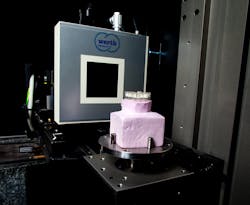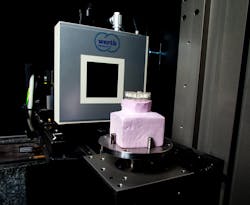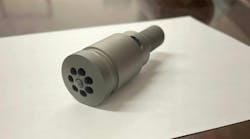By Bruce Geiselman
Parts as small as a speck of dust are nothing to sneeze at. For Isometric Micro Molding, they’re a calling card.
In some cases, 1,000 parts can be produced from a single plastic pellet and the final parts can weigh as little as 0.00004 gram, said Donna Bibber, the Wisconsin company’s VP of business development. Other parts made by the micromolding specialist can be the size of a quarter, but have microscopic features, such as chips with microfluidic channels that are used in blood analysis.
“We started out making the molds for many OEMs in the Twin Cities area because we’re about 40 minutes from the Minneapolis-St. Paul Twin Cities area,” Bibber said.
Over the years, at the urging of its customers, Isometric expanded to begin micromolding, with ultra-precise automated assembly and in-line inspection of miniaturized devices.
Related: Micromolders find their fit
“It’s all customer-driven here,” Bibber said. “We started out as a mold maker, as a lot of molders did back then.”
In 2008, Isometric added automated assembly systems, custom-designed for miniaturized medical and drug-delivery assemblies. In 2014, it purchased a second building and installed micromolding presses to produce parts primarily for medical devices. At the same time, the company bought a Werth computed tomography (CT) scanner that inspects the internal part geometries of micromolded parts and assemblies to ensure they meet specifications; typical tolerances are in the single-micron range.
Isometric defines micromolded parts as meeting one of the following descriptions: consisting of fractions of a plastic pellet in overall size; requiring micron tolerances; or having a high-aspect-ratio wall thickness or, in the case of larger parts, having micro features that can best be seen with the aid of magnification of 20x or greater.
Precise mold design is one of the most important risk-mitigation strategies for successfully producing micromolded parts, Bibber said.
“The first and foremost challenge is generating a good, solid mold design capable of longevity even though the core pins and ejectorIn some cases, that means the mold must be built to a tolerance of within 3 microns (1 micron is equal to 0.00004 inch).
“This really sets micromold builders apart from others, working to these types of tolerances under environmentally controlled conditions,” she said.
To meet those demands, Isometric has 42 mold makers on staff, 10 of whom are mold designers.
“The mold is truly the enabling technology to creating micromolded components as well as micro automated assemblies,” Bibber said. “Having this skill set in-house is critical to understanding the risks associated with micromolding and mitigating those risks from mold design through validation.”
To create molds with accurate geometries, Isometric uses a variety of equipment, including Yasda multi-axis micromilling machines, Sodick microwire EDMs, Sodick micro EDMs and Mitsubishi wire EDMs.
Precise operation of the injection molding machines also is essential.
“One of the most difficult aspects of using a traditional molding press is the residence time of the press — how long the resin stays in the barrel and screw, as well as the injection pressure and how precise and consistently they produce the expected shot size,” said Brent Hahn, Isometric’s global director of sales.
If the resin stays in the barrel too long, it will degrade. If the injection pressure and shot size are not consistent, the quality of the parts will suffer.
Isometric avoids those problems by using injection molding machines specifically designed for micromolding.
The company uses 12 micromolding machines, including Sodick presses with clamping forces ranging from 10 to 60 tons.
After the parts are molded, Isometric’s in-house automated assembly systems remove them — sometimes dust-speck-sized — from the molds. Custom-designed vision inspection systems then determine whether they are in spec. Six-axis Epson robots assemble the parts, bond them together, if needed, and package them.
At the micro level, manual assembly is impossible.
Isometric produces a variety of very small plastic parts that are used for surgical and medical products that are saving and extending lives, and implantable drug delivery systems for providing pain management and treatment, Hahn said. The parts include implantable devices like pacemaker components, bioresorbable implants, sensors and robotic surgery components that are inserted into a patient’s body through endoscopes. The company also manufactures screws and tissue anchors out of bioresorbable resins.
Contact:
Isometric Micro Molding Inc., New Richmond, Wis., 715-246-7005, [email protected], https://isomicro.com








